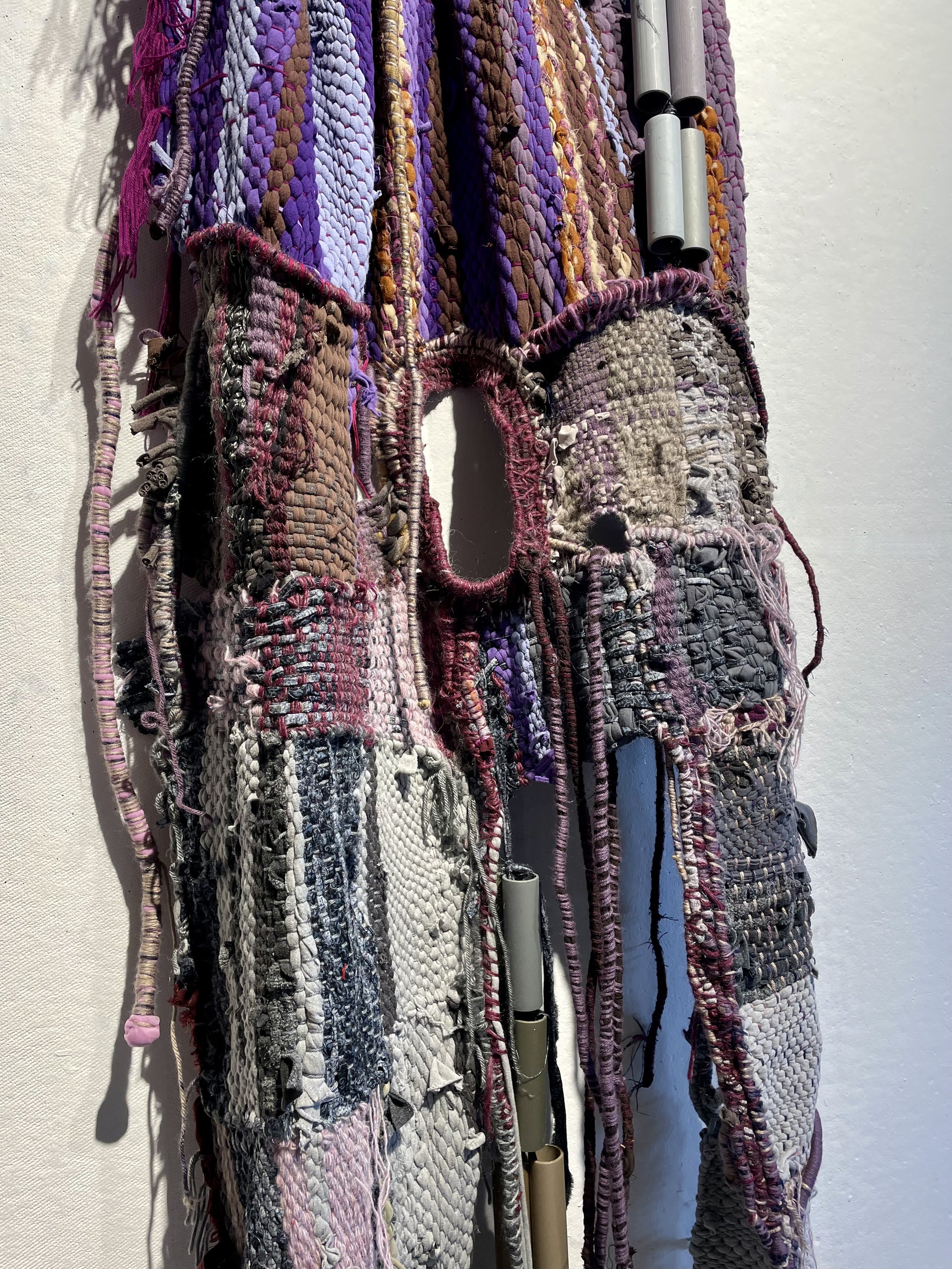All Galleries
Kingston Associates|Grey Areas
August 2nd - August 27th, 2023
Opening Reception Friday August 4th, 5:00 - 8:00 pm
About:
This year’s annual exhibition by Kingston Gallery’s Associate Artists explores the theme Grey Areas from different perspectives and media. As a collective of artists who have collaborated over the past year to produce this exhibit, the ten artists interpret our world with divergent approaches to both the enigmatic concept and the color “grey.” As artists, they explore liminal places, ideas, and eras that generate questions - many without answers. Responding to the existential areas of an unknowable future or the space between ecosystems, they wonder how to acknowledge non-human collaborators, the myriad “what-ifs” of depression, and the question of secrecy and abuses in institutions and systems of government that operate in obscurity. The diversity of work plays with grey’s ability to take on hue and enliven color, consider the spin of the stories we tell, uncertainty in understanding our world, and the difficulty of truly knowing the space one occupies in that world.
Grey Areas features the following artists: Stacey Cushner, Sally Dion, Madge Evers, Jim Fenzel, R. Galvan, Jane Lincoln, Jeffrey Nowlin, Jade Olson, Brett S. Poza, and Anne Sargent Walker. Press images can be downloaded here. Full Artist biographies are available here. Highlights from the show for each artist are included below. Public programming will be announced in July 2023..
Selected Works
Stacey Cushner. "Spaces that people pass through, dawn to dusk, a space that lingers between rain and sunshine are all liminal spaces, grey spaces, in-between spaces. The work that I have produced for this show combines chiefly drawing with graphite and charcoal on canvas or board and are of spaces between the living and the dying. Broken trees, crispy brown leaves, roadkill, fires, and temperature changes causing severe weather against blue skies, fox kits, chirping birds, and budding flowers is the area we live in."
Sally Dion: "Those liminal spaces in life and relationships where it is difficult to understand or realize where you should be. From teenager to adult, completing your education and finding a job, having children. My drawings have always been about those grey areas. The lines of my drawings join to create an anthill hierarchy of the human figure. Thoughts and ideas taken from real life as a mother, wife, teacher, and friend, I follow the stories that are all around me. My drawings often include actual happenings and big news items as they may relate to me but always in the grey areas. I carefully consider the female archetype and how it became part of my drawing and what characters populated my version of history. I am constantly protesting and proclaiming my message with my work and asking “Why do we do art?” For me it’s that story memorializing love, loss and imperfection in the various chapters we pass through.
Madge Evers: "I’m interested in the transformative qualities of decomposition and in an exploration of processes and products of organic materials, have adapted the spore print, a mushroom identification tool typically used by mycologists and foragers, to create biomorphic monochromatic works on paper. Like the wind and other animals, I spread the spores of mushrooms; I germinate their powdery spores as they land on paper and create my version of a fruiting body - its form a two-dimensional image rather than toadstool. In this interdependence with mushrooms, I wonder: How do I best acknowledge my unwitting collaborators?"
Jim Fenzel: "For over one hundred years in the United States and Canada, government and church-run schools carried out a mission to assimilate Native American children and save them by “killing the Indian in the child.” Operated by trusted organizations, some schools propagandized their “successes,” but all hid their abuses; many, too, hid the bodies of children who died in their care. Only recently did the ongoing discovery of unmarked graves shine a light on the darker history of Residential Schools. My work for this show looks at the Native experience not just at the schools but how the removal of children from their culture impacted generations. The schools existed in grey areas of trust and secrecy, and the lives of the survivors and their descendants continue under the heavy shadows of those institutions."
R. Galvan: "For the Associates summer exhibition, my contribution will focus on gray areas as uncertainty. What does memory look like? By employing newsprint and photographic reproduction to dematerialize snapshots, I’m bringing attention to invisible qualities of spatial organization that structure the ways we understand the world we inhabit. Misaligned grids parallel an individual struggle to hold a memory in focus, or to find perfection in an unstable world. And, warped and rippled paper evidence a spatial ground that struggles to present a unified image."
Jane Lincoln: "I speak as a colorist when I say that gray is malleable and accommodating. One can purchase N3, Neutral Gray, or mix white with black, but gray is rarely seen as colorless because it is not seen in isolation. If a neutral gray is surrounded by an intense blue, the gray will appear to have a tint of orange. Simultaneous contrast results from the fact that for any given color the eye simultaneously requires the complementary color. This occurs as a sensation in the eye of the viewer, and is not tangibly present. It cannot be photographed. It is the color sensations which my eye experiences that propels my work. For Gray Areas I have focused on where gray subtly takes on a hue, and is enlivened by a pure color. I manipulate the hand painted bands of paper until my eye achieves the desired effect. Each painting has a shadow of color around the edges which connects across the surface. I wish to enliven a viewer’s experience with color."
Jeffrey Nowlin: "MDD (Blackberry) represents the complex, interwoven mantle of major depressive disorder. As it hangs, the piece presents an entry point into the world of this disorder, burdensome and heavy. I am creating a work which functions in space; I ask the viewer to consider what the myriad of, “what if’s”, indecision, regret, intractable pain, and the neurotic infinity of depression delivers to the sufferer . A patchwork of episodes, understood through rag weaving, coalesces into a meandering meditation on what it is to functionally plod through the day, on the best of days. The memorial quilt speaks in the vernacular of the Black American patchwork quilting tradition. It is meant not to aestheticize racialized violence. Not to ignore the injustice system. Not to abstract the terms police brutality and internalized white supremacy. This memory quilt is understanding for me. Asphalt gray, sodium street lamps, penumbra of emergency vehicles lights fluoresce- these optical data inform my color choices of the work. The process is consuming, raw and layered. It is taking time to remember that the conversation in the USA about systemic police violence and abuses continues to be unclear, ill-defined as a fundamental problem of freedom. We live in a grey zone when it comes to how American society chooses to structure its system of law and order, to balance what is enough and what is overkill. The piece remembers a young man who loved photography and skateboarding. Let’s remember the textured pieces of his life that made him, not the night that his life was stolen from him."
Jade Olson: "Through painting and ceramic sculpture, Jade Olson explores a realm where imagination rules, and triumph coexists with failure. Growing up in poverty and religious cultism, while also suffering child abuse, art provided Olson with an escape from reality. She found solace in the narratives of superheroes, sentient robots, and iconoclasts, seeing them as symbols of power, hope, and inspiration. In Olson’s work, heroic figures are complex. Colorful, large-scale paintings depict powerful champions engaged in struggle – a group of sumo wrestlers spilling outside the ring in a struggle – or or in moments of self doubt and vulnerability – a superhero breaking apart into an existential scream. Vivid reds and golds evoke passion and movement contrasting with the grays and blues of frustration. Similarly, Olson’s sculptures of robots encourage the viewer to engage with the idea of what it means to be human, and to think about our relationship with technology. Working with ceramics and simple electronics, robot forms are given intentional limitations and exaggerated proportions. At 30” tall, their scale is unimposing. The durable medium of ceramic removes their agency – they cannot move – and so they must invite the viewer’s attention with their facial expression. Rather than being cold and precise, these robots are psychedelic, charming, smudged, ultimately inept, and hoping for empathy. Ceramics are glazed in colorful, painterly passages and then subjected to multiple firings. Glazes bubble, melt, and crack, spilling over the form, indicating both vibrancy and vulnerability. Metallic parts are finished in gold and copper. Olson’s painted and sculpted figures refer back to Greek athletes depicted on ceramic jars and in marble, as well as to Haniwa figures and Congo power figures. “Self Building Robot” is a direct response to the Greek sculpture “Apoxyomenos.” Through her paintings and sculptures, she seeks to delve into the profound significance that superheroes hold in our collective imagination and their ability to transcend the ordinary, tapping into the universal human desire for strength, hope, and the power to overcome adversity."
Brett S. Poza: "My art practice always begins with photos, which I compile as a kind of sketchbook of references. I then research what I have documented, and look at the implications from both a factual and a metaphorical perspective. I see stories in the environment around me, in the relationships between trees, other things that are struggling to survive, are isolated or images such as diagnostic artifacts that represent uncertainty. My preference is to work on grain free plywood, which in the case of images of trees, seems almost ironic, given how far removed plywood is from being a tree. Images are drawn and burned into the surface using a variety of techniques, creating a highly textured and patterned surface. Color is applied with stains, dyes and colored pencils, complementing the already detailed textures. I consider the work successful if it stimulates a conversation- inviting people to connect to nature, to difficult experiences and quiet narratives they may not have anticipated."
Anne Sargent Walker: "Grey Areas refers to an existential uncertainty- what will our world look like in 10 years, 50, 100 years? Memories of the world of the past combine with visions of how it might look in future. I will be working more abstractly for Grey Matters, combining natural elements such as birch bark or lichen with man made ones such as collaged wallpaper and photographic images. Small areas may be painted. Tones will be grey or pale. Memories fade and the future is unseeable….The format will be 12 x 12” squares. I hope to produce at least four of them."










